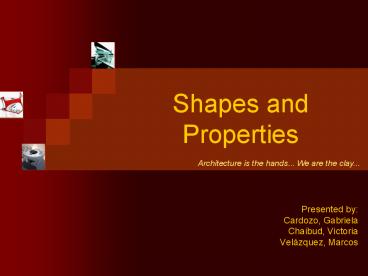Shapes and Properties - PowerPoint PPT Presentation
1 / 15
Title:
Shapes and Properties
Description:
Shapes and Properties Architecture is the hands... We are the clay... Presented by: Cardozo, Gabriela Chaibud, Victoria Vel zquez, Marcos Shapes and Properties ... – PowerPoint PPT presentation
Number of Views:65
Avg rating:3.0/5.0
Title: Shapes and Properties
1
Shapes and Properties
Architecture is the hands... We are the clay...
- Presented by
- Cardozo, Gabriela
- Chaibud, Victoria
- Velázquez, Marcos
2
How can forms be described and classified? What
are the most common shapes founded in our homes
and classroom? How can architects nowadays
create forms?
3
Geometric Shapes
Basic Shapes
Circle
Polygon
Solids
Cube
Prism
Cylinder
Sphere
Organic Shapes
4
Basic Shapes
Circle
We can communicate with other people through
spoken language, which is the result of mixing
basic elements like letter, words, phrases etc.
That generates complex communication systems.
But that is not the only way to communicate,
the visual communication is other way, and also
is the result of mixing some basic elements like
point, line and plane, these elements create
several shapes. These shapes can be categorized
in geometric and organic. We can separate
geometric shapes in basic shapes and solids.
Basic shapes are all those essential forms that
can generate the rest of shapes making some
variation on some of their components. These can
be Circles, Triangles and Quadrilaterals.
Polygon
5
Basic Shapes
Circle
One of the most useful geometric shapes is the
circle. It plays a vital part in our livesin
wheels, in all sorts of containers, in machine
parts, in design, and in architecture. The circle
provides the most economical form of shelter.
Round houses are used in the Arctic and at the
equator.
Polygon
A circle is the set of points in a plane
equidistant from a fixed point in the plane
called the center. The circle receives its name
from the center.
6
Basic Shapes
Circle
Polygons are evident in all architecture. They
provide variation and charm in buildings. When
applied to manufactured articles such as printed
fabrics, wallpapers, and tile flooring, polygons
enhance the beauty of the structure itself.
Polygon
Triangle
The word polygon is derived from the Greek words
meaning many angles. A polygon is a closed plane
figure formed by three or more line segments
which intersect only at their endpoints. Each
endpoint is common to exactly two segments.
Quadrilaterals
7
Basic Shapes
Circle
A triangle is a polygon that has three sides. The
triangle is the simplest and one of the most
familiar of all polygons. It is used in
construction and design of every description.
Polygon
Triangle
We see it in the framework of buildings and
bridges. Because it is a rigid figure, the shape
of a triangle cannot be changed when pressure is
applied to it. For this reason the triangle
provides an excellent support for many
structures.
Quadrilaterals
8
Basic Shapes
Circle
A quadrilateral is a polygon with four sides. The
most common quadrilaterals are the parallelogram,
rectangle, square, rhombus, and trapezoid. It is
a very familiar polygon used in architecture.
Ceilings, floors, walls, windows and doors
usually are quadrilaterals.
Polygon
Triangle
Quadrilaterals
9
Solid
Cube
They are in the field of three-dimensional
shapes. Solids are composed figures. The most
basics solids are cube, prism, cylinder and
sphere.
Prism
Cylinder
Sphere
10
Solid
Cube
Is a block with all right angles and whose
height, width and depth are all the same.
Something that is shaped like a cube is
sometimes referred to as cubic. This solid is a
combination of squares.
Prism
Cylinder
Sphere
11
Solid
Cube
Is a polyhedron with two congruent and parallel
faces (the bases) and whose lateral faces are
parallelograms. Two of the most known prisms are
triangular and rectangular, which depend on the
shape of the parallel faces. If the base of a
triangular prism is a square it is called a
pyramid.
Prism
Cylinder
Sphere
12
Solid
Cube
A cylinder is a solid object that has a circular
base and a height. If a cylinder is cut parallel
to the base the resulting shape (called a
cross-section) would be a circle of the same
shape. A deformed cylinder on one of the
extremes, united as an apex it is called a cone
Prism
Cylinder
Sphere
13
Solid
Cube
Points in the 3 dimentional space which are
uniformly and symmetrically allocated at a fixed
distance, called radius of the sphere. A sphere
is a shape in space that is like the surface of a
ball . Also a cross section of a sphere is a
circle.
Prism
Cylinder
Sphere
14
Organic Shapes
Have no pattern to classify or relate them with
geometrical forms. Most of the time they try to
imitate nature, as an abstract way. In the wide
field of architecture there have been a constant
need to create new forms or transform the
existent ones. There are no rules to create
organic shapes, because each architectural
project have different conditions and
requirements. The shape tried to obtain will
depend on the physic characteristics of spaces,
which will give us the tools to make the most
appropriate organic shape.
15
When we initially look at a building, we see
geometric solids. We see a myriad of rectangular
prisms, the workhorses of architecture, along
with triangular prisms, pyramids, cylinders,
cones, and spheres. Sometimes these solids are
combined with each other to form complex
structures. This relationship between geometric
solids is especially noticeable in roof shapes.
While the basic building shape may be a
rectangular prism, the roof may be a triangular
prism. It could consist of additional triangular
prisms along with rectangular prisms, spheres or
cones that may project beyond and/or above the
roof.































